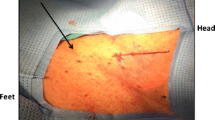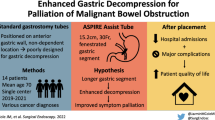Abstract
We inserted a long intestinal tube via the percutaneous transgastric route in three patients with an inoperable malignant bowel obstruction. The percutaneous endoscopic gastrostomy technique facilitated this method. The main purpose of our procedure is to achieve direct intestinal de-compression without nasal intubation, which is not always possible by venting gastrostomy alone. Palliative intestinal decompression proved to be effective in all patients. This alternative therapeutic strategy for managing bowel obstruction in terminal cancer patients is herein presented.
Similar content being viewed by others
References
Gelmo B, Rayner AA, Lewis B, Wong A, Vielen CS, Ungaretti JR, DeLorimier AA, Hohn DC (1986) Home support of patients with end-stage malignant bowel obstruction using hydration and venting gastrostomy. Am J Surg 152:100–104
Malone JM Jr, Koonce T, Larson DM, Freedman RS, Carrasco CHO, Saul PB (1986) Palliation of small bowel obstruction by percutaneous gastrostomy in patients with progressive ovarian carcinoma. Obstet Gynecol 68:431–433
Stellato TA, Gauderer MWL (1987) Percutaneous endoscopic gastrostomy for gastrointestinal decompression. Ann Surg 205:119–122
Picus D, Marx MV, Weyman PJ (1988) Chronic bowel obstruction: value of percutaneous gastrostomy tube placement. AJR 150:295–297
Kadota T, Nakagawa K, Taguchi J, Ono H, Hiraide H, Tamakuma S, Ueno F (1991) A simplified percutaneous endoscopic gastrostomy using the trocar introducer technique with peel-away sheath. Surg Gynecol Obstet 173:491–494
Gowen GF, DeLaurentis DA, Stefan MM (1987) Immediate endoscopic placement of long intestinal tube in partial obstruction of the small intestine. Surg Gynecol Obstet 165:456–458
Ochsner A (1977) The relative merits of temporary gastrostomy and nasogastric suction of the stomach. Am J Surg 133:729–732
Paes EH, Rahmer H, Almon W (1986) Temporary Witzel enterostomy in decompensated small-bowel obstruction or paralytic ileus. Acta Chir Scand 152:521–525
Grant JP (1993) Percutaneous endoscopic gastrostomy: initial placement by single endoscopic technique and long-term follow-up. Ann Surg 217:168–174
Brown AS, Mueller PR, Ferrucci JT Jr (1986) Controlled percutaneous gastrostomy: nylon T-fastener for fixation of the anterior gastric wall. Radiology 158:543–545
Funada M, Nakagawa H, Sasaki T, Deguchi A, Kawamura K (1991) Percutaneous endoscopic gastrostomy — report of a new gastropexy technique (in Japanese). Gastroenterol Endosc 33: 2681
Lee MJ, Saini S, Brink JA, Morrison MC, Hahn PF, Mueller PR (1991)Malignant small bowel obstruction and ascites: not a contraindication to percutaneous gastrostomy. Clin Radiol 44:332–334
Author information
Authors and Affiliations
Rights and permissions
About this article
Cite this article
Shinoda, M., Kojima, M., Fukase, T. et al. Percutaneous transgastric intestinal decompression: The management of malignant bowel obstruction without nasal intubation. Surg Today 24, 937–939 (1994). https://doi.org/10.1007/BF01651015
Received:
Accepted:
Issue Date:
DOI: https://doi.org/10.1007/BF01651015




